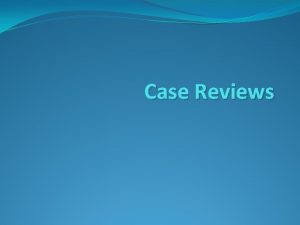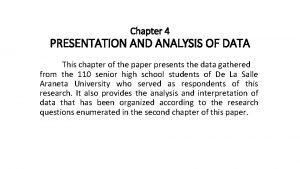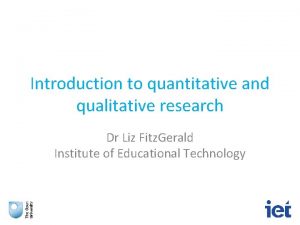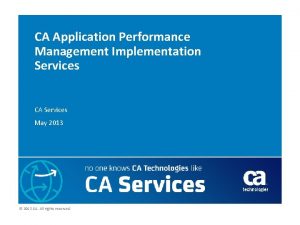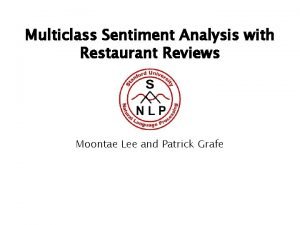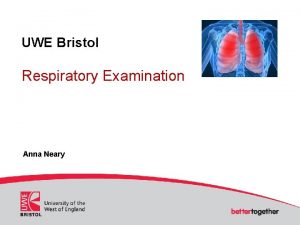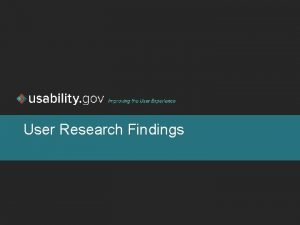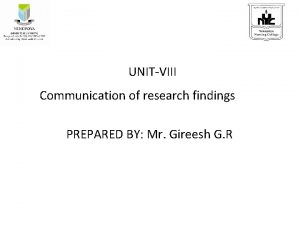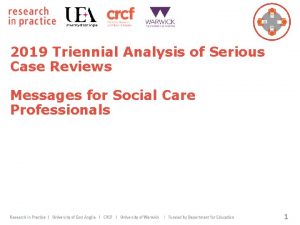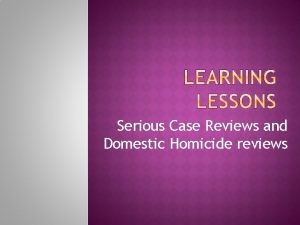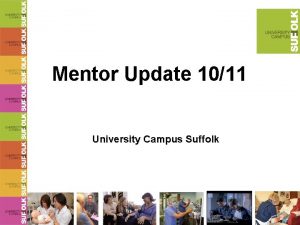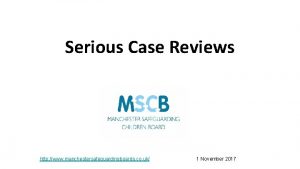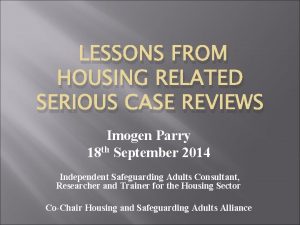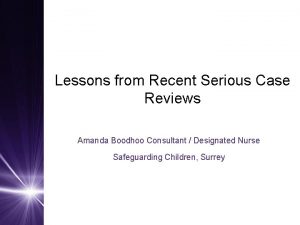2019 Triennial Analysis of Serious Case Reviews Findings












- Slides: 12

2019 Triennial Analysis of Serious Case Reviews Findings are based on a quantitative analysis of all 368 SCRs notified to the Df. E between 1 April 2014 and 31 March 2017 and qualitative analysis of a sample of 63 SCR reports. 1

2019 Triennial Analysis of Serious Case Reviews Key Themes § The complexity of the lives of children and their families. § Service Landscape – The challenges for practitioners of working with limited resources, high caseloads, high levels of staff turnover and fragmented services. § Poverty – The impact of poverty which created additional complexity, stress and anxiety in families alongside other cumulative harms. § Child Protection – Once a child is know to be in need of protection, with a CP Plan, the system generally works well. 2

2019 Triennial Analysis of Serious Case Reviews Areas of Learning Four key areas from the report. Neglect § Complexity and cumulative harm were almost invariably a feature where children experienced neglect. § Poverty leads to additional complexity, stress and anxiety in families, which can in turn heighten the risk of neglect or abuse. § Children living in poverty often experience poor social, emotional and behavioural outcomes, and impaired cognitive and language development. Key Message Rectifying the physical manifestations of poverty and a chaotic lifestyle does not equate with children being safe. 3

2019 Triennial Analysis of Serious Case Reviews Neglect – Adolescent Neglect § There is insufficient understanding of adolescent neglect across the multi-agency network and its link with complex adolescent behaviour. § Clear pathways for transition to Adults’ Services are important to ensure young people receive the care and support they need. Key Message An incident-based approach to Child Protection and the identification of neglect has served adolescents poorly. When each involvement with a family is treated as a discrete event, information is not accumulated and professionals do not develop a comprehensive understanding of the child’s life experiences. 4

2019 Triennial Analysis of Serious Case Reviews Areas of Learning The briefing concentrates on four key areas from the report. Vulnerable Adolescents § The report finds local neighbourhoods were a source of significant risk, as young people were often not in school, going missing and seeking a sense of belonging away from the family home. § There is evidence that some practitioners were still slow to recognise and respond to vulnerability to CSE, particularly if the child was male. § Understanding adolescents’ experiences – including family life, adverse early childhood experiences, local community and wider social networks – is necessary for understanding adolescent harm. § Some children and young people were both victims and perpetrators of harm to other children; all needed support and safeguarding. There was a tendency to see them as troublesome rather than troubled. 5

2019 Triennial Analysis of Serious Case Reviews Vulnerable Adolescents – Key Message Police and their partner agencies need to improve understanding on the front line that adolescent criminal activity may be an indicator of wider exploitation and vulnerability. Responses need to recognise vulnerability and not focus solely on criminal processes. 6

2019 Triennial Analysis of Serious Case Reviews Areas of Learning The briefing concentrates on four key areas from the report. Multi-Agency Working (information sharing, language and communication). § Problematic multi-agency working continues to result in lost opportunities for protecting children from harm. The number of different agencies involved in delivering care can result in fragmented and un co-ordinated care. § ‘Silo-working’ may occur within, as well as between, agencies. § Many assessment and planning tools are not fit for purpose and are used ineffectually. § Key professionals were not present or not invited to Ci. N or CP. § The role of the Lead Professional was often not clear. § New policies or joint working protocols were often not used or sufficiently embedded in practice. 7

2019 Triennial Analysis of Serious Case Reviews Multi-Agency Working (Information sharing, language and communication) § The language used to talk about children’s circumstances can hinder or support effective safeguarding. § Some services may be unclear about what information should be shared and when. § Some professionals had limited understanding of the legal framework and were unclear about their roles and responsibility for children on supervision orders. Key Message Referral forms, assessment tools and incident-logging tools should all encourage the use of language that properly and explicitly depicts issues in ways that do not dilute impact and harm, or the reality of life for the child. 8

2019 Triennial Analysis of Serious Case Reviews Areas of Learning The briefing concentrates on four key areas from the report. Enabling Children to Have a Voice § The absence of the child’s voice and their lived experience is a recurrent theme in the report. § A number of SCRs found health visitors, many whom had very high caseloads, focused only on specific tasks. § Issues relating to ethnicity are not adequately addressed. This includes how cultural beliefs and expectations impact on the care and wellbeing of the child. Ethnicity may be recorded but the implications for the day–to-day lives and experiences of the children are not explored and spelled out. 9

2019 Triennial Analysis of Serious Case Reviews Areas of Learning The briefing concentrates on four key areas from the report. Enabling Children to Have a Voice § Understanding the emotional world of a child requires a more rounded rather than incident led approach; too often the underlying causes and the lived experience of the child are not explored. § Particular attention should be paid to those children who, through communication or learning difficulties or because of their home circumstances, may find it difficult to express their experiences. 10

2019 Triennial Analysis of Serious Case Reviews Overarching Issues from the report found: § The complex and cumulative nature of neglect, often in the context of poverty, was not understood or recognised. § The risk of harm to adolescents may be hidden and hard to recognise. There is a need to develop a better understanding of the social and environmental context of the risks and harm adolescents face outside the family. § There is a need to focus more on thorough single and multi-agency assessments and clear agency plans at all stages of the process. They should also include better recognition of ethnicity, identity and culture. 11

2019 Triennial Analysis of Serious Case Reviews In your groups, address how agencies and professionals could work to improve the two concerns below. § The complex and cumulative nature of neglect, often in the context of poverty, was not understood or recognised. § The risk of harm to adolescents may be hidden and hard to recognise. There is a need to develop a better understanding of the social and environmental context of the risks and harm adolescents face outside the family. 12
 Serious case review victoria climbie
Serious case review victoria climbie Nvocc license application
Nvocc license application Best worst and average case
Best worst and average case Presentation and analysis of data
Presentation and analysis of data Analysis and findings example
Analysis and findings example Ca application delivery analysis reviews
Ca application delivery analysis reviews Sentiment analysis of restaurant reviews
Sentiment analysis of restaurant reviews Sentiment analysis for hotel reviews
Sentiment analysis for hotel reviews Qualitative paper example
Qualitative paper example Anna neary
Anna neary Research findings example
Research findings example Communication of research findings
Communication of research findings What is quantitative example
What is quantitative example
